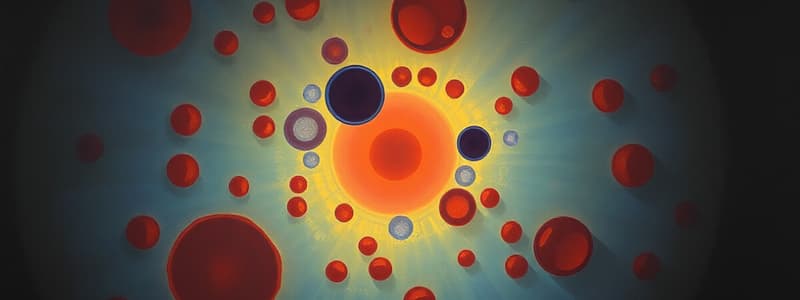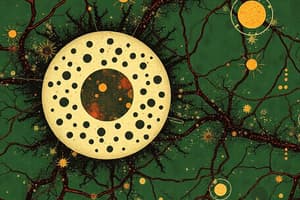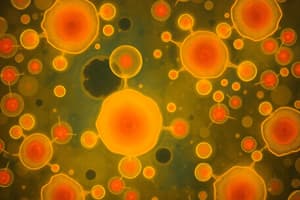Podcast
Questions and Answers
What is the primary function of the cytoplasm?
What is the primary function of the cytoplasm?
- Protein synthesis
- Photosynthesis
- Cell shape and material transport (correct)
- Genetic material storage
What does the plasma membrane regulate?
What does the plasma membrane regulate?
Concentrations of certain substances in and out of a cell.
What is housed within the nucleus?
What is housed within the nucleus?
Chromosomes made of chromatin.
What is the main function of ribosomes?
What is the main function of ribosomes?
Define the structure of Rough ER.
Define the structure of Rough ER.
What function does Smooth ER perform?
What function does Smooth ER perform?
What is the role of the Golgi apparatus?
What is the role of the Golgi apparatus?
What is the difference between endocytic and exocytic vesicles?
What is the difference between endocytic and exocytic vesicles?
What enzymes do lysosomes contain?
What enzymes do lysosomes contain?
What is the main function of mitochondria?
What is the main function of mitochondria?
What process do chloroplasts carry out?
What process do chloroplasts carry out?
The central vacuole is primarily responsible for ______.
The central vacuole is primarily responsible for ______.
What is the main component of plant cell walls?
What is the main component of plant cell walls?
Which of the following structures prevent leakage of extracellular fluid?
Which of the following structures prevent leakage of extracellular fluid?
What is the function of microtubules?
What is the function of microtubules?
What do intermediate filaments provide to the cell?
What do intermediate filaments provide to the cell?
What are microfilaments known for?
What are microfilaments known for?
Flashcards are hidden until you start studying
Study Notes
Cytoplasm
- Contains cytosol (jelly-like substance) and organelles; fills the cell and is composed of 80% water.
- Provides cell shape, aids in material transport and storage, facilitates movement, and protects genetic material.
- Composed of non-living inclusions, which include stored fats and sugars for cellular respiration.
- The cytoskeleton within the cytoplasm aids in maintaining the cell's shape and movement.
Plasma Membrane
- Found in both prokaryotic and eukaryotic cells, surrounds the cell.
- Comprised of a phospholipid bilayer with hydrophobic inner parts and hydrophilic outer parts.
- Embedded proteins may have carbohydrate side chains; regulates substance concentrations and maintains cell shape.
Nucleus
- Surrounded by a nuclear envelope with pores; connects with the endoplasmic reticulum.
- Houses chromosomes made of chromatin and nucleoli for ribosomal subunit production; pores control material entry/exit.
Ribosomes
- Composed of two subunits made of ribosomal RNA and proteins, located freely in cytosol or bound to rough ER.
- Primary function is protein synthesis.
Rough Endoplasmic Reticulum (Rough ER)
- Network of membranous sacs (cisternae) studded with ribosomes for protein synthesis.
- Plays a role in assembly of proteins and is involved in membrane synthesis.
Smooth Endoplasmic Reticulum (Smooth ER)
- A tubelike structure without ribosomes, making up about 10% of the cell.
- Synthesizes lipids, produces hormones, detoxifies drugs, and stores calcium ions.
Golgi Apparatus
- Composed of flattened sacs (cisternae) with cis/trans faces, present in eukaryotic cells.
- Receives, sorts, repackages proteins from the rough ER for transportation to various destinations.
Endocytic and Exocytic Vesicles
- Membrane-bound vesicles involved in transporting materials in and out of the cell.
- Endocytic vesicles form from the plasma membrane to take in particles, while exocytic vesicles transport materials out of the cell.
Lysosomes
- Membranous sacs containing hydrolytic enzymes in animal cells.
- Function in the breakdown and recycling of macromolecules, damaged organelles, and ingested substances.
Peroxisome
- Specialized metabolic compartments encased by a single membrane.
- Contain enzymes that produce hydrogen peroxide and convert it into water, involved in various metabolic reactions.
Mitochondria
- Double-membraned organelles, with inner membranes folded to increase surface area.
- Site of cellular respiration, producing ATP for energy.
Chloroplast
- Enclosed by two membranes surrounding a stroma containing thylakoids stacked into granum.
- Function primarily in photosynthesis, converting light energy into chemical energy.
Central Vacuole
- Large vesicle with a selective membrane found only in plant cells.
- Maintains water balance, stores waste, isolates harmful materials, aids in plant growth, and contains pigments and enzymes.
Cell Wall
- Composed of cellulose in plants, peptidoglycan in bacteria, and chitin in fungi.
- Provides structural support, protection, and limits flexibility, helping maintain cell shape and preventing excessive water influx.
Cell Junctions
- Gap junctions allow chemical communication between adjacent cells.
- Tight junctions create barriers preventing leakage, while desmosomes anchor cells together.
Centrosome and Microtubules
- Centrosomes organize microtubule assembly, containing a pair of centrioles.
- Microtubules, hollow rods composed of tubulin, support cell shape, guide organelle movement, and aid in cell division.
Intermediate Filaments
- Composed of fibrous proteins that form cables; provide structural support and anchorage for organelles, and reinforce cell shape.
Microfilaments
- Composed of actin, these thin filaments provide support to the cell and are crucial for cell motility and division.
- Form a gel-like network in the cortex of the cell, contributing to muscle contraction during cellular activities.
Studying That Suits You
Use AI to generate personalized quizzes and flashcards to suit your learning preferences.




